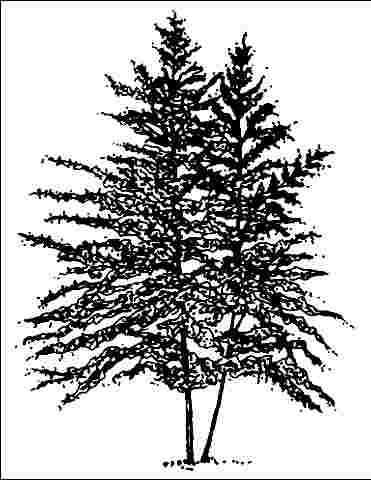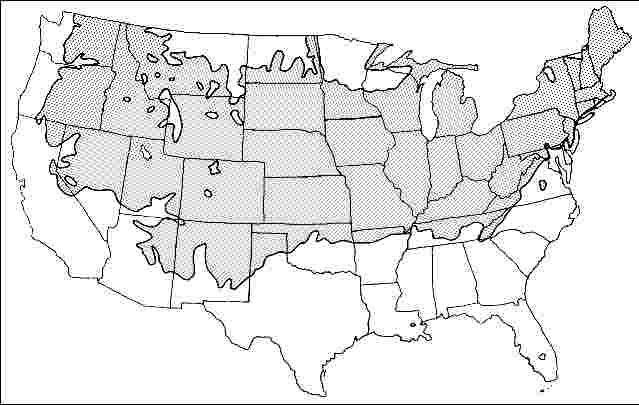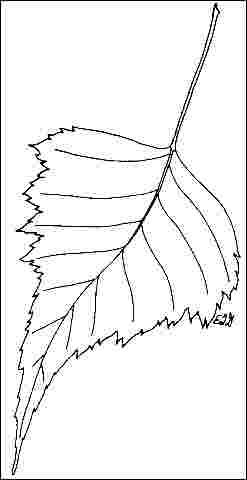Introduction
A small, North American native tree, gray birch reaches 20- to 30-feet in height with a 10- to 20-foot spread, often forming loose, open thickets in the wild but easily trained to a single, slender trunk with an irregular, upright, pyramidal silhouette. The glossy, dark green leaves on reddish-brown twigs are triangular-shaped, 2.5- to 3.5-inches long, and turn a lovely yellow color in autumn before dropping. Both male and female catkins, or blooms, appear on the same tree, eventually producing a small cylindrical cone, with the male catkins persisting on the trees well into the winter. For the first four or five years, the bark of gray birch is dark brown but later takes on a smooth, chalky-white appearance but does not peel as readily as the bark of white birches.

General Information
Scientific name: Betula populifolia
Pronunciation: BET-yoo-luh pop-yoo-lih-FOLE-ee-uh
Common name(s): Gray birch
Family: Betulaceae
USDA hardiness zones: 4A through 6B (Fig. 2)
Origin: native to North America
Invasive potential: weedy native
Uses: specimen; reclamation; container or planter
Availability: somewhat available, may have to go out of the region to find the tree

Description
Height: 20 to 30 feet
Spread: 10 to 20 feet
Crown uniformity: symmetrical
Crown shape: upright/erect, pyramidal
Crown density: open
Growth rate: moderate
Texture: fine
Foliage
Leaf arrangement: alternate (Fig. 3)
Leaf type: simple
Leaf margin: double serrate
Leaf shape: ovate
Leaf venation: pinnate
Leaf type and persistence: deciduous
Leaf blade length: 2 to 4 inches
Leaf color: green
Fall color: yellow
Fall characteristic: showy

Flower
Flower color: brown
Flower characteristics: not showy
Fruit
Fruit shape: elongated
Fruit length: .5 to 1 inch, 1 to 3 inches
Fruit covering: dry or hard
Fruit color: brown
Fruit characteristics: attracts birds; not showy; fruit/leaves not a litter problem
Trunk and Branches
Trunk/bark/branches: branches droop; showy; typically one trunk; thorns
Pruning requirement: little required
Breakage: resistant
Current year twig color: brown, gray
Current year twig thickness: thin
Wood specific gravity: unknown
Culture
Light requirement: full sun, partial sun or partial shade
Soil tolerances: clay; sand; loam; acidic; slightly alkaline; occasionally wet; well-drained
Drought tolerance: moderate
Aerosol salt tolerance: high
Other
Roots: not a problem
Winter interest: yes
Outstanding tree: no
Ozone sensitivity: tolerant
Verticillium wilt susceptibility: resistant
Pest resistance: sensitive to pests/diseases
Use and Management
With the attractive bark, persistent catkins, and interesting, finely branched silhouette, gray birch makes a striking winter landscape planting, especially against a backdrop of dark green evergreens. Gray birch exhibits medium to fast growth (two feet per year) and is relatively short-lived, approximately 20 years. It could be used as specimen tree where a small- to medium-sized, fine-textured, upright plant is needed.
Gray birch will grow easily in full sun or partial shade on almost any soil, tolerating the poorest, driest soils to wet, streamside locations. It is an early colonizer of recently disturbed sites, growing best alone with little competition from other vegetation, and often forms pure stands in nature from seedlings and root suckers. It may suffer if interplanted with other competing shrubs and ground covers. Trees will show symptoms of chlorosis when grown on soil with a high pH. Any necessary pruning should be done in summer or fall since trees pruned in late winter or early spring will bleed excessively.
Cultivars include 'Laciniata'—pinnately-lobed leaves; 'Pendula'—drooping branches; and 'Purpurea'—purple young leaves.
Propagation is by seeds or cuttings.
Pests and Diseases
None of major concern but occasionally bothered by leaf miners and cankers. Gray birch is quite resistant to bronze birch borer.
